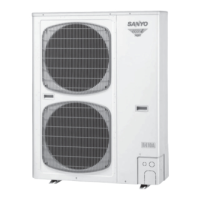Replacement of Main Units
TD831077
VII-6
7
1. Compressors
6.
Close valve V9 and open valve V6 and inspect for leaks. (Keep the pressure within the 1.27 to 1.47 MPa (13-15 kg/cm
2
)
range in order to protect the low-pressure switch.) (Ref. Fig. A)
Under no circumstances, do not exceed pressure 1.47 MPa (15 kg/cm
2
). Otherwise the low-pressure switch
becomes damage.
When the refrigerant has been recovered in the PC unit, inspect for leaks using a refrigerant gas
pressure of 0.98 MPa (10 kg/cm
2
).
7. If no leaks are found, close valve V6 and open valve V9, and prepare for establishing a vacuum. Mount the parts
which were removed at the previous stage. (Ref. Fig. A)
NOTE
(2) Replacing the constant-speed AC com-
pressor (Ref. Fig. 2)
* If the power cable interferes and makes it impossible
to replace the AC compressor, refer to “(1) Replacing
the PC compressor” on the previous page.
[Removal]
1. Remove the front panel at the front.
2. Remove the sound-proofing material which is
wrapped around the compressor.
3. Remove the cap over the compressor terminal
section, and disconnect the power and internal
terminals. (Do this in two places at the left and
right.)
4. Remove the crankcase heater.
5. Remove the three bolts.
6. Prepare to remove the welded areas.
¶ Protect the sensor unit and the plate, rubber,
leads and clampers around it.
7. Remove the three welded areas.
8. Lift and draw the compressor out toward you.
[Installation]
1. Prepare to install the compressor.
¶ Remove the cross oil pipe from the failed
compressor. Before removing the pipe, tilt the
compressor toward the opposite side to that of
the cross oil pipe to return the oil inside the
cross oil pipe to the compressor.
¶ Remove the stoppers over the outlet and intake
ports of the new compressor. Mount the crank-
case heater.
¶ Place the compressor on its side, and attach the
cross oil pipe. Remove the upper flare nut.
Loosen the lower flare nut, hold the cross oil
pipe and connect it as quickly as possible. (Have
a pan ready.)
¶ Mount the flare nuts and other parts which were
removed from the new compressor onto the
failed compressor.
2. Install the compressor in the outdoor unit.
(Be absolutely sure to check the compressor’s
model number. The AC compressor’s model
number has the suffix “B” or “C”.)
3. Install the pipes.
4. Replace the air inside the pipes with nitrogen. (If the
pipes have not been inserted, discharge a small
amount of the nitrogen while using a burner to apply
heat to them, and insert. Use wet cloths or other
suitable materials to cool off the surrounding pipes.)
1869_M_I
Cloth
Welded areas (×4)
(Area A)
Area where pipe
is to be cut
Crankcase heater
Bolts (×3)
Power terminal
Internal terminal
Before drawing out
the compressor,
spread a cloth under
it to protect the bottom
panel from damage.
Cross oil pipe
Fig. 2

